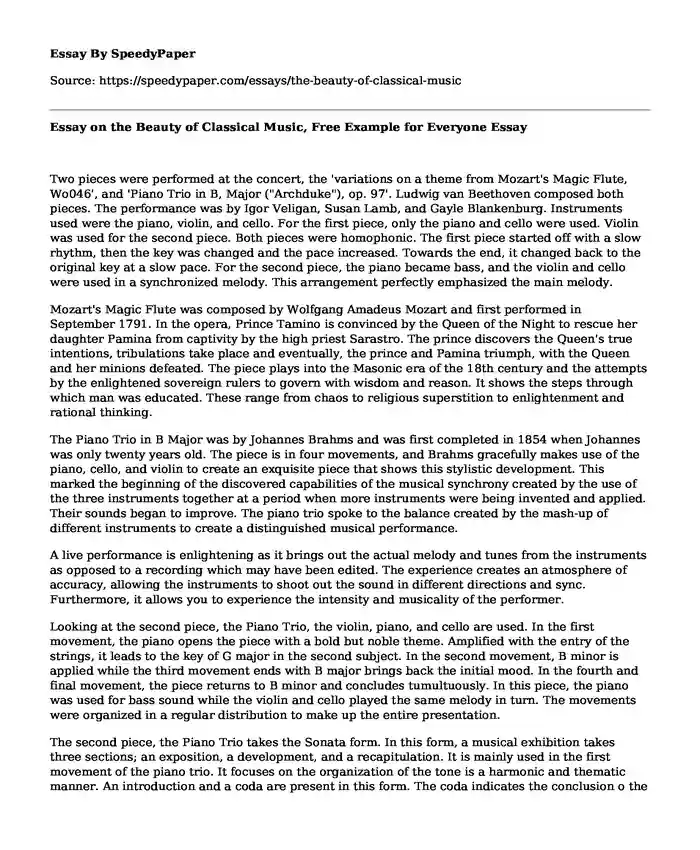Two pieces were performed at the concert, the 'variations on a theme from Mozart's Magic Flute, Wo046', and 'Piano Trio in B, Major ("Archduke"), op. 97'. Ludwig van Beethoven composed both pieces. The performance was by Igor Veligan, Susan Lamb, and Gayle Blankenburg. Instruments used were the piano, violin, and cello. For the first piece, only the piano and cello were used. Violin was used for the second piece. Both pieces were homophonic. The first piece started off with a slow rhythm, then the key was changed and the pace increased. Towards the end, it changed back to the original key at a slow pace. For the second piece, the piano became bass, and the violin and cello were used in a synchronized melody. This arrangement perfectly emphasized the main melody.
Mozart's Magic Flute was composed by Wolfgang Amadeus Mozart and first performed in September 1791. In the opera, Prince Tamino is convinced by the Queen of the Night to rescue her daughter Pamina from captivity by the high priest Sarastro. The prince discovers the Queen's true intentions, tribulations take place and eventually, the prince and Pamina triumph, with the Queen and her minions defeated. The piece plays into the Masonic era of the 18th century and the attempts by the enlightened sovereign rulers to govern with wisdom and reason. It shows the steps through which man was educated. These range from chaos to religious superstition to enlightenment and rational thinking.
The Piano Trio in B Major was by Johannes Brahms and was first completed in 1854 when Johannes was only twenty years old. The piece is in four movements, and Brahms gracefully makes use of the piano, cello, and violin to create an exquisite piece that shows this stylistic development. This marked the beginning of the discovered capabilities of the musical synchrony created by the use of the three instruments together at a period when more instruments were being invented and applied. Their sounds began to improve. The piano trio spoke to the balance created by the mash-up of different instruments to create a distinguished musical performance.
A live performance is enlightening as it brings out the actual melody and tunes from the instruments as opposed to a recording which may have been edited. The experience creates an atmosphere of accuracy, allowing the instruments to shoot out the sound in different directions and sync. Furthermore, it allows you to experience the intensity and musicality of the performer.
Looking at the second piece, the Piano Trio, the violin, piano, and cello are used. In the first movement, the piano opens the piece with a bold but noble theme. Amplified with the entry of the strings, it leads to the key of G major in the second subject. In the second movement, B minor is applied while the third movement ends with B major brings back the initial mood. In the fourth and final movement, the piece returns to B minor and concludes tumultuously. In this piece, the piano was used for bass sound while the violin and cello played the same melody in turn. The movements were organized in a regular distribution to make up the entire presentation.
The second piece, the Piano Trio takes the Sonata form. In this form, a musical exhibition takes three sections; an exposition, a development, and a recapitulation. It is mainly used in the first movement of the piano trio. It focuses on the organization of the tone is a harmonic and thematic manner. An introduction and a coda are present in this form. The coda indicates the conclusion o the movement. The movements are distinguished by the way in which they accomplish their objective and produce the distinct sounds while creating specific moods. The contrasting styles are contained in the exposition, which is in the movements. The Piano Trio exhibits the characteristic of the sonata form. The performance was carefully articulated and organized from start to finish, just as per the requirements of the sonata form.
Rhythm in the performance created a repetitive pattern in the Piano Trio. This pattern establishes a pattern through which we draw musicality. The rhythm helps to capture the attention of the audience and allows them to follow through with the performance. In the piano trio, the instruments, especially the strings, created a specific rhythm that was captivating. We listen to music, and the first element we pick up is the rhythm. Therefore the rhythm determines the most notable features of a musical performance. The instruments used different tone variations and patterns to create a rhythm that is the foundation of any musical piece.
Comparing two concerts I've attended, the similarities are notable. For instance, keen measures, such as quality speakers, amplifiers, and microphones, are in place to ensure the quality of sound is outstanding. The performers put in their best effort to give a memorable performance. The lighting is also perfected to improve the visual aspect. Similarly to what I learned in class, I observed that key signatures, rhythm variation, and intonation are very important in determining the quality of a performance.
Cite this page
Essay on the Beauty of Classical Music, Free Example for Everyone. (2022, Jun 16). Retrieved from https://speedypaper.net/essays/the-beauty-of-classical-music
Request Removal
If you are the original author of this essay and no longer wish to have it published on the SpeedyPaper website, please click below to request its removal:
- Essay Example on Biotic and Abiotic Factors in an Ecosystem
- Improving the Healthcare System in UAE - Essay Sample
- Free Essay on Representing 9/11 in the Hollywood Cinema Chapter 24
- Essay Sample That Highlights Gender Inequality in Employment in the UK
- Is Video Gaming a Sport? Article Analysis Essay Example
- Essay Sample on Prohibition in the 1920s
- Themes in the Cold War Era - Paper Example
Popular categories





